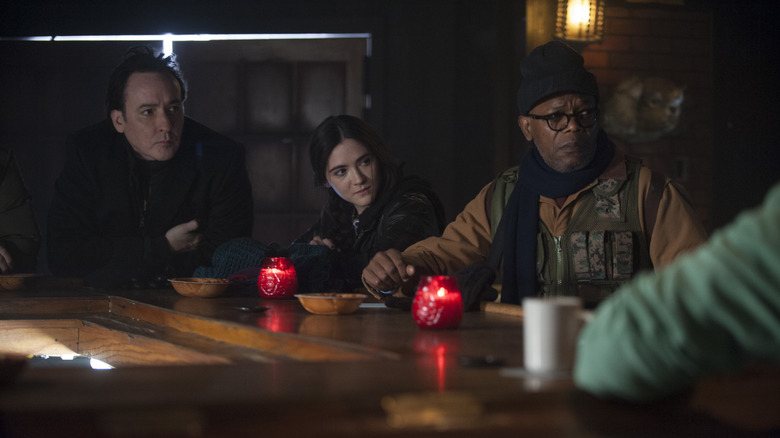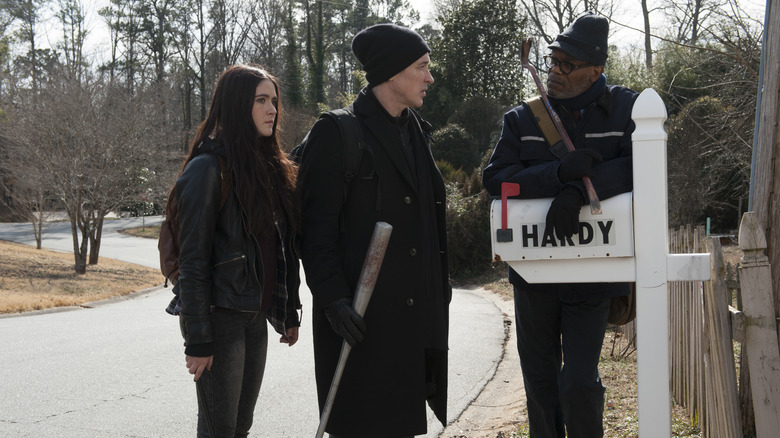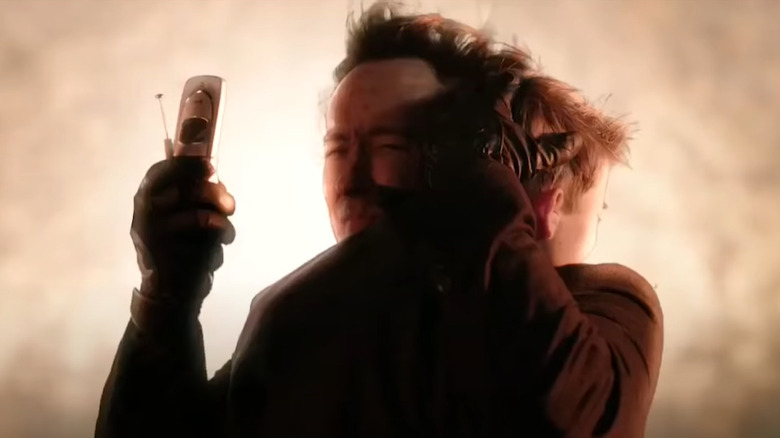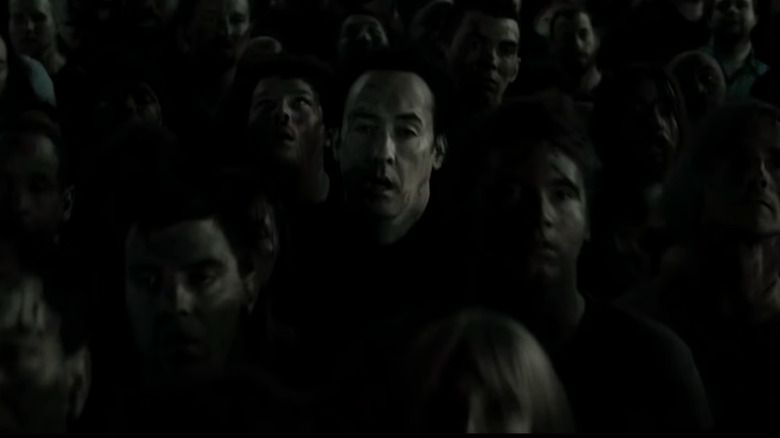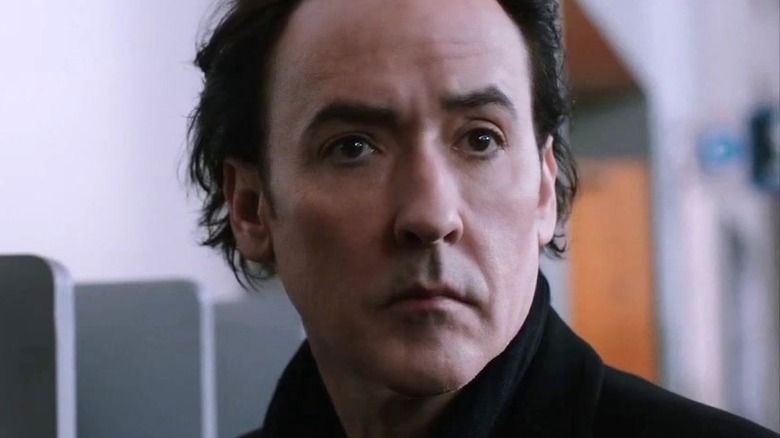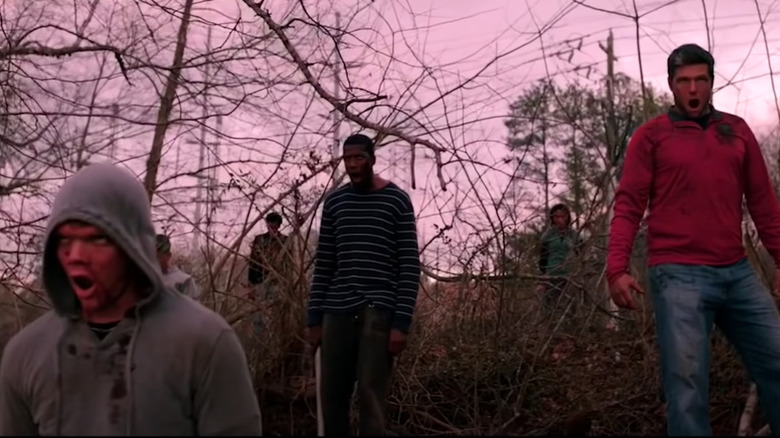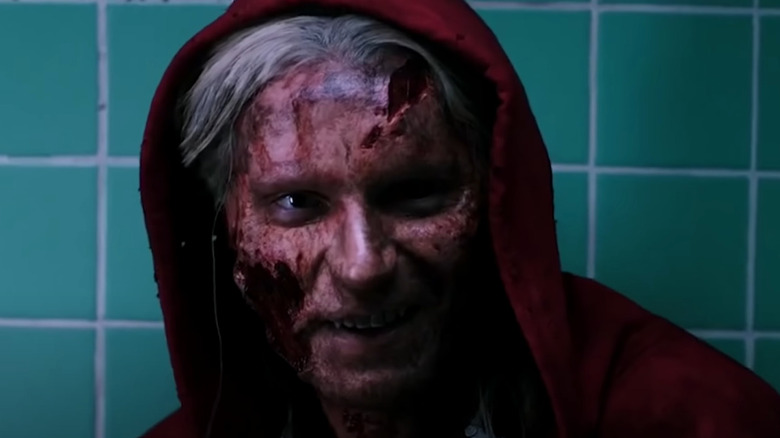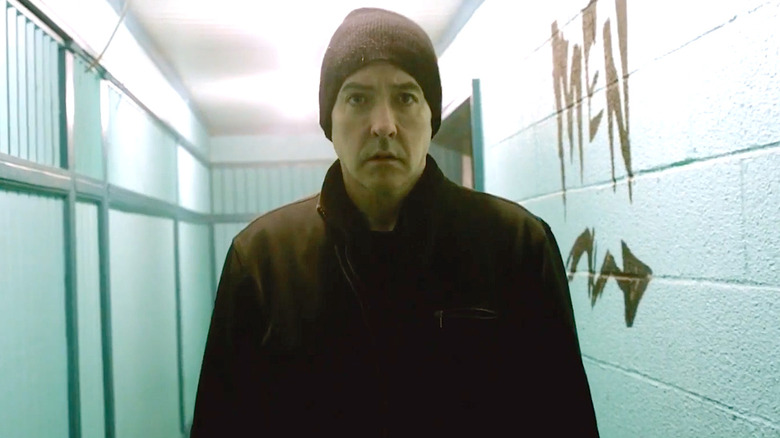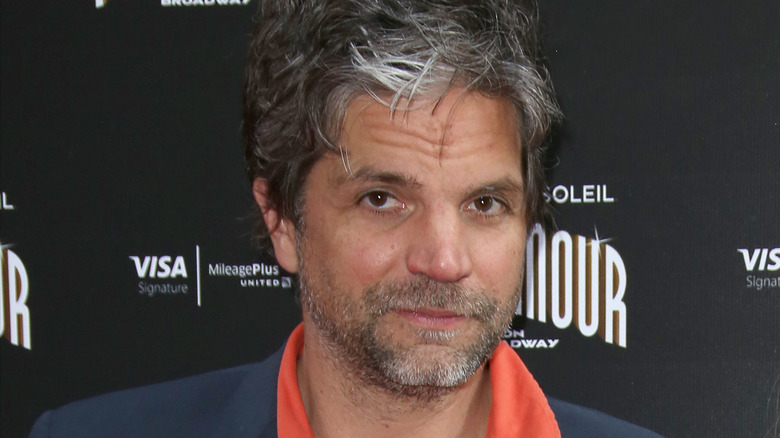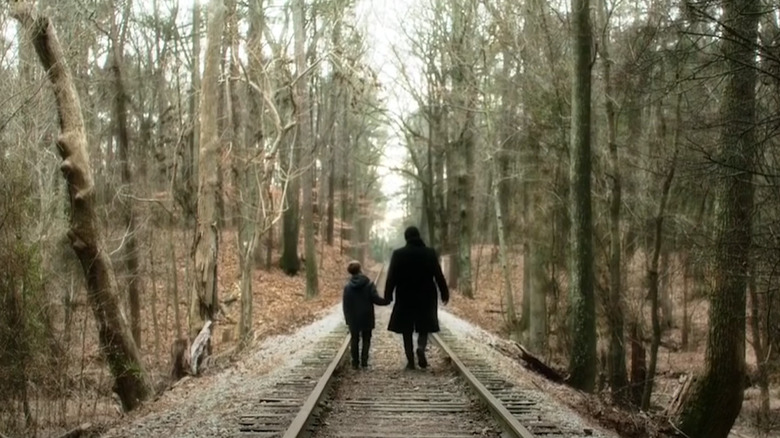The Ending Of Cell Explained
The genre of zombie films is one that never seems to die. But amidst the horde of zombie flicks that live on in cinemas and streaming services, 2016's "Cell" sought to be a little bit different.
Adapted from a 2006 Stephen King novel of the same name, the film was not only the latest of his works to get a screen adaptation, but it was also a reunion between "1408" stars John Cusack and Samuel L. Jackson. At the beginning of "Cell," we're introduced to Clay Riddell (Cusack), a local artist who's just hit it big, thanks to a lucrative deal for a graphic novel titled "Night Traveler" he's been hoping to publish. After a brief phone call that reveals him to be a divorced father with a strained relationship with his ex-wife Sharon and son Johnny, disaster strikes. While traveling through a packed Boston airport, a deadly attack known as "the pulse" is launched through people's cell phones, turning users into mindless and murderous shells of their former selves, which we come to know as "phoners."
By the end of the film, however, there are plenty of questions left unanswered, and even a few confusing moments worth talking about. But have no fear — we'll explain the ending of "Cell," and also cover some of what director Tod Williams has said about the film since.
What you need to remember about the plot of Cell
While trying to escape from the airport, Clay meets transportation worker Thomas McCourt (Jackson), and the pair quickly team up against the deadly new menace plaguing the city. After returning to Clay's apartment, they also meet fellow survivor Alice (Isabelle Fuhrman), before arming up and heading out of Boston. For Tom and Alice, the goal is simply to survive and better understand what's happened to the world. but for Clay, the situation is even more dire, as he hopes to reunite with his son and ex-wife. That is, if they're still alive.
Along their travels, they meet other survivors, some of whom opt to join them, and others who instead meet grisly fates. Their first stop is at a former school whose only remaining occupants are the headmaster and a single student named Jordan (Owen Teague), who later joins their group. It's there that they discover a horde of phoners lying dormant, a temporary weakness that they take advantage of in violent fashion. Later, the group learns of a mysterious figure who appears only in their dreams known as "The Raggedy Man," with some unknown connection to the phoner flocks.
From there, our band of plucky survivors continue traveling north, learning of a potential safe haven called Kashwak, that's either entirely free from phoners or instead a clever trap. Along the way, they sadly lose Alice, and later join with a pair of wanderers from whom Clay obtains an ice cream truck packed with explosives. But when Clay finally reaches his destination, he comes to the realization that his journey isn't quite over yet.
What happened at the end of Cell?
In the final act of the film, Clay and the rest of the group finally reach his family's home, only to make a heartbreaking discovery. Not only is Clay's son Johnny nowhere to be found, with a note left behind on the fridge for his father revealing that he's headed to Kashwak, but we learn that at some point since the pulse, his ex-wife Sharon has been turned into a phoner. Worst still, Clay winds up discovering her locked in the attic, forcing him into a duel that nearly cuts his journey short.
With a renewed hope that his son is still alive, Clay decides to make the perilous drive up to Kashwak, despite the insistence from the others in his group that it's a trap. It's here that he parts ways with them, telling Jordon to spray paint "TJD" every few miles so that he'll be able to find them later. Not long after, he arrives in Kashwak, only to find the proclaimed safe zone swarmed with more phoners than we've ever seen at once, all circling a massive telephone tower with a being known as the Raggedy Man at its base.
After making his way through the stampede and defeating the Raggedy Man, in a grim reveal, Clay finally reunites with Johnny only to realize that he's since been infected. Now out of options, he remotely detonates the explosive truck, taking out the horde of phoners and their leader in a final sacrificial act. Or did he?
What the ending of Cell means
In the final few minutes of the film, we're shown a trio of different scenarios that could easily wind up confusing some viewers. First, we're shown Clay embracing Johnny before detonating the explosive truck he'd been traveling in. Moments later, there's a vision of him walking with his son and following the signs to Canada. Lastly, a final scene shows the horde of phoners once again surrounding the cell tower, with Clay now among their ranks.
While the three different outcomes all seem to point in different directions, they actually are all the true endings ... in a sense. In Clay's mind, he took out the massive horde and somehow survived the explosion, before embarking on a journey with Johnny to regroup with Tom and the others. In reality, however, he became infected by the pulse sometime after arriving at Kashwak, with the first two scenes being nothing more than figments of his imagination. This suggests that all phoners we've seen so far may similarly be living in a fantasy world, unaware of the truly horrific fate that befell them.
On a less literal note, "Cell" also delivers commentary on humanity's relationship with technology, none of which is too positive. It's no coincidence that cell phones were chosen as the means by which millions of people were transformed, with the film making a clear statement on the zombie-like connections many of us admittedly have with our own personal devices.
Another possible meaning behind the ending of Cell
Though it may be confusing the first time around, once the pieces are put together, the ending of "Cell" is pretty straightforward. However, as fans on Reddit have speculated, there's more than one way to interpret the ending. In a post on the r/horror subreddit, a user responded to a request for clarification on the ending by providing their own take on the film as a whole: "If he survives or dies doesn't matter, thing is this whole thing is from his imagination. It's the Night Walker story coming to an end. I honestly believe the whole thing from start to finish was in his head. Is he a Phoner? If Phoners actually exist, yes probably. Who is to say he isn't working his crappy job he said he used to have and daydreaming about his dream job of making comics? It's very open-ended."
Though we're shown Clay hanging up his phone just moments before the outbreak, it's important to remember that what we see may not always be reality. The most likely explanation for the ending is that the final explosion at Kashwak was probably all in Clay's head. Therefore, it isn't that much of a stretch to argue that he may have been infected by the pulse much earlier in the film, perhaps even becoming one of the first victims at the airport. Or, as the theory speculates, it may all be nothing more than an artist's day-dreaming session.
What was the Pulse?
Though at first glance the pulse seems to have many similarities to the classic zombie apocalypse scenario audiences are already familiar with, there are several key differences. Unlike most zombie outbreaks, the pulse's primary method of transmission is technological, spreading to its victims through the use of their cell phones. Much like a cellular network, the affected phoners then become similarly linked as one collective hive mind. This is shown by an early encounter Clay and others have with one of the infected, who alerts nearby phoners to their presence simply by sight. Later, and shortly after meeting Ray and Denise, a captured phoner is shown to be a "canary in a coal mine," reacting violently if a flock of its peers is nearby.
In exchange for the unique strengths that those who have fallen victim to the pulse receive, there are some drawbacks as well. The need to hibernate en masse at night is a glaring weakness that Tom and Clay exploit early on, and unlike zombies, phoners are typically as easy to dispatch as a normal human. In light of these weaknesses, however, they're shown to evolve in the film, going from mindless killing machines to later gaining the ability to spread the pulse to new victims.
Who was the Raggedy Man?
First shown to us in a disturbing nightmare that Clay experiences, the Raggedy Man is soon revealed to have been a character in the same graphic novel that Clay had been ready to publish before the outbreak of the Pulse. But while that could simply be explained by the fact that he's dreaming of a character he created before the events of the film, a deeper mystery begins when we learn that Tom, Alice, and the rest of the survivors have all begun dreaming of the mysterious man as well.
Believed to be the leader of the phoners, he's shown to have the power to work his way into the minds of the uninfected, and even come back from the dead with ease. Unfortunately, despite his existence presenting a number of questions, none of the most burning ones are truly answered by the time the credits roll. Instead, we're left to speculate with what we do know, which is that if we're to believe the events of the film as they're presented, then Clay truly did conceive the idea of the Raggedy Man prior to the pulse. With that in mind, and when accounting for the limited number of people who could have known of the character, it's safe to assume that the events of the pulse are intimately connected to at least one of the people in Clay's life. Who they are and how they're responsible for it, though, are left open to interpretation.
What did the movie change from the source material?
Though the film adaptation of Stephen King's original novel had plenty of issues for most viewers, it was at least still partially the author's vision. With a screenplay written by King, "Cell" remained more accurate to the book than a number of past attempts at adapting his stories taken on by other writers. But for all the ways it stayed true to the source material, "Cell" still wound up changing quite a bit, including some pretty crucial elements present in the original story.
Certain character deaths wind up playing out entirely differently, such as the headmaster of Jordan's school, Charles. In the film, he's tragically killed after the group sets fire to the flock of dormant phoners, while in the novel he's driven to suicide by the telepathic link that phoners have to the uninfected. Similarly, when Alice is killed in the novel, her death is dragged out, and is also frequently interrupted by the Raggedy Man effectively possessing her.
On an even broader scale, certain aspects of the phoners were omitted from the film adaptation. Their telepathic connection was fleshed out to a greater degree, with the Raggedy Man even shown to have the ability to give them commands. Lastly, the more grim ending that we see in the film played out in a fairly more hopeful way in King's original novel, with Clay successfully defeating the Raggedy Man and the story ending with Johnny having a chance to be brought back from his infected state.
What has director Tod Williams said about Cell?
Perhaps best known for helming the sequel to "Paranormal Activity" back in 2010, "Cell" marked only the fifth title in director Tod Williams' 20+ years as a filmmaker. In 2023, he appeared in an interview on the Stephen King-focused podcast "The Losers Club," where the director shed some light on what it was like behind the scenes on the horror flick.
The incredibly rocky production process of "Cell," with nearly a decade between the film's first announcement and eventual release, became an immediate topic of discussion. When asked if he was familiar with what he was getting into, Williams stated, "You know, I didn't and I should have ... But when I came on board it was already clear that there was a sort of battle going on about the movie between John Cusack and Richard Saperstein (the film's producer), and they were looking to me to try to overcome the other. It was a pretty complicated development process with some strong opinions on both sides. And ultimately, I'm not sure we resolved it."
Later on in the interview, and on the topic of adapting the film in its entirety, Williams openly acknowledged the challenge behind such a venture, saying, "Obviously the scope of the book is unbelievably ... I mean, to show the whole thing would have been unbelievably expensive. It would've been humongous, and it would've been a miniseries." He went on to add, "I think that's one of the big challenges with Stephen is often the books seem cinematic but the truth is they're just way too big."
What have critics said about Cell?
Despite being one of the most acclaimed authors of our time, and perhaps the most famous to dabble in the realm of horror, Stephen King's track record when it comes to film adaptations has been spotty at best. Sure, some certified hits have become genre staples, such as Stanley Kubrick's "The Shining" (which King famously hated), but for every "Shining," there's also a "Lawnmower Man," which changed so much from its source material there was practically no relation to its short story roots.
Thankfully, the changes we saw in "Cell" were kept to a minimum by comparison. But what we did get failed to sit well with the majority of critics, who lambasted everything from the film's editing to more crucial elements such as the plot itself. In a review for the Chicago Sun-Times, critic Richard Roeper was unimpressed with the film, stating, "'Cell' is not a polished work of filmmaking. Some of the nighttime scenes are so poorly lit it's difficult to tell what's happening. The editing is ragged and adds to the confusion. More than a few of the supporting performances are embarrassingly amateurish." In a separate review, Noel Murray of the Los Angeles Times said that the film was guilty of "stringing together one stale confrontation after another in mostly nondescript locations."
Audience reviews were only marginally better, with review aggregator Rotten Tomatoes showing an audience score of just 17%.
Will we ever see a sequel to Cell?
Given that "Cell" only received a limited theatrical release back in 2016, the film's meager box office take of just over $1 million shouldn't be much of an obstacle for a potential cinematic follow-up. What could have played a much larger role in generating momentum for another entry would have been a positive reception from critics and audiences which, as we've already discussed, was far from the case for "Cell." Furthermore, the fact that Stephen King hasn't released any continuation to the film's source material does admittedly leave prospects for a potential sequel looking bleak.
But despite the lack of compelling evidence to suggest that a sequel is on anyone's mind, it still might not be the last time fans see an adaptation of "Cell" hit the big screen. As one of the most adapted authors in history, several of Stephen King's works have first appeared as low-budget, direct-to-television fare, only to be reimaged years later with big studio bucks in hand. As proof of this in practice, look no further than titles like 1989's "Pet Sematary" or 1990's "IT," which both received a much more professional and costly remake in 2019 and 2017, respectively. Sure, it took a few decades, but it's worth holding out hope for dedicated fans of King's novel.
